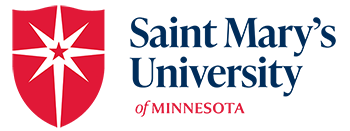Saint Mary's Newsroom
Campus ConnectionAn update from the president to alumni and parents
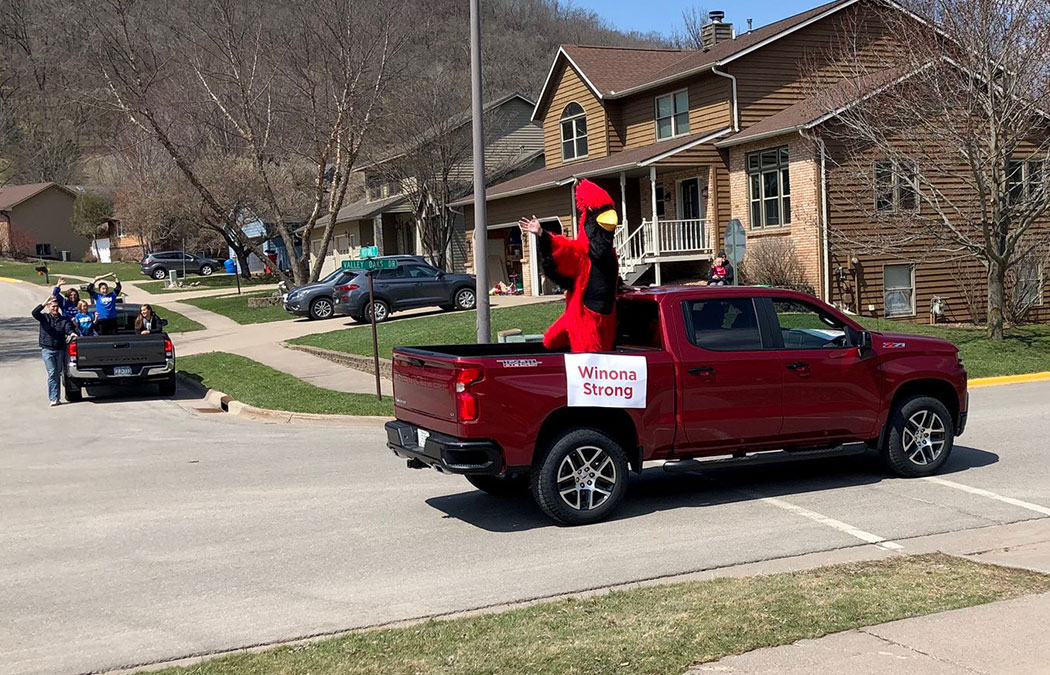
Strengthening community
In these times of uncertainty, it’s important to remember that we are “stronger together.” This past week, Saint Mary’s donated mattresses to Catholic Charities and participated in a mini parade with Cotter High School.
Big Red waved to community members (viewing from safe distances) during the Cotter Community “Stay Strong” Mini-Parade Friday, April 17. The parade wound around Winona for a couple of hours and was available for viewing on Facebook Live.
The parade was sponsored by Cotter Community Partners: WNB Financial, RTP Company, Slaggie Family Foundation, Fastenal, Dahl Auto, Winona Family Dental, Kohner Materials, Leighton Broadcasting, Alliant Castings, Miller Scrap, Merchants Bank, Midtown Foods, Schwab LLC, Saint Mary’s University of Minnesota, Altra Federal Credit Union, and River Hills Dental.
Thanks to Tim Gossen, Ed.D., vice president for Student Affairs and Student Life, and Ann Merchlewitz, J.D., general counsel and university secretary, for helping us share some Saint Mary’s spirit and a message of hope!
Saint Mary’s recently donated 20 mattresses to Catholic Charities to be used at the Rochester Community Warming Center, which will remain open until the end of May. As a result of the COVID-19 pandemic, they found themselves in need of more mattresses for the additional people seeking refuge at the warming center. The Saint Mary’s maintenance staff moved quickly to prepare the mattresses. Though they requested 15 mattresses, Saint Mary’s was able to provide them with 20. They expressed their appreciation for such a quick response.
Saint Mary’s Zoom backgrounds for work and life
As people spend more and more time each day on Zoom, for work meetings, distance learning and even to connect with family and friends, adding a bit of fun to the experience is necessary and easy. We’ve all seen Zoom backgrounds featuring well-known landmarks, tropical destinations, and serene settings. But if you’re missing Saint Mary’s, we have a series of Zoom backgrounds to help you feel a bit more at home whether connecting personally or professionally.
Find Zoom backgrounds to download (must be logged in with your Saint Mary’s login information.)
To change the default Zoom background image:
- Log in to the Zoom web portal.
- Click Room Management > Zoom Rooms.
- Click Account Settings at the top of the page.
- In the Account Profile tab, under Background image for Zoom Rooms, click Upload New Image. …
- Select your image and click Open.
Book rental return information
The Saint Mary’s Bookstore is temporarily closed until further notice, and rental books cannot be returned in person at this time. Watch the email account you used to rent books for an email with order numbers for returns and buyout information.
Please send your rental books back no later than Monday, June 15. When you’re finished with your rental books, you can print a free UPS label to ship them back to the bookstore.
After you generate the label, make sure you pack the books carefully so they do not sustain any damage in transit. If books arrive damaged, we will be unable to check them in. You can drop off the package at any UPS location.
Find FAQs and more information about returning your rental books.
Please keep in mind that you can only print one label. Please do not ship out your package until all rented books are included. As soon as we receive the package from UPS, we will check your books in, and you will receive an email confirmation.
You may choose to buy out your rental books until the due date of Monday, June 15. The purchase price will be at a reduced rate, and you will own the book once you buy it with no need to return.
If you have any questions or concerns, email sm417@bncollege.com. Please include your name and the phone number you used to rent your books.
If you left Saint Mary’s rental books in your residence hall, please complete this form by Monday, May 11, for Student Life to retrieve and return for you.
Students inducted into Alpha Psi Omega
Several students and one faculty member were inducted as members of Alpha Psi Omega (APO), National Theatre Honors Fraternity, on Sunday, April 5. The induction ceremony took place in a Zoom meeting led by Rachel Rougas ’20, president of APO, and Judy Myers, professor and faculty adviser to APO. The election of new officers will take place prior to the end of the spring semester.
Inductees must be at least a sophomore with an overall GPA of 3.0 and GPA of 3.5 in their major. They must also build up points in their theatre work that includes both onstage and backstage work.
Congratulations to these new inductees:
- Anna C. Dale ’21
- Erin Elizabeth Grams ’22
- Laura Elise Herronen ’22
- Nathan Peter Huberty ’22
- Ahnika Lexvold ’20
- Sarah Danielle Phipps ’22
- Marlee Gabrielle Ressa ’21
- Ana Paula Saldana Cicneros ’22
- Makenzie Grace Tafralian ’22
- Clarissa M. Van Dale ’22
- Isaiah Taylor West ’22
- Jimmy Bickerstaff, Ph.D., associate professor
Members of APO who are graduating in May 2020 include:
- Olivia Beauchamp
- Annabeth Kerr
- Emma Lay
- Ahnika Lexvold
- Rachel Rougas
- Celeste Russell
- Trevor Wagner
Diversity Cafe is back as part of Talk About It Tuesday
Diversity Cafe tomorrow at 4 p.m.
Miles Dunna, J.D., assistant director for Diversity and International Recruitment, will be hosting Diversity Cafe this week on the topic of privilege and allyship via Zoom on Tuesday, April 21, at 4 p.m. Watch for the link on the Student Activities Facebook and website.
Reminder of Bingo this Wednesday at 3:30 p.m.
Join us for Mental Health Bingo, hosted by the Student Wellness Club, Wednesday, April 22, at 3:30 p.m. Learn about mental health, socialize, and maybe even win a prize (which will be distributed later). Questions? Contact Molly Cary at mgcary17@smunmn.edu.
Check out the Student Wellness Club Instagram to stay updated on events, fun health tips, and more.
University Writing Services support
There are now two ways to get help from University Writing Services.
1. Feedback via Google Docs from Writing Studio tutors. To get feedback on your paper, sign up for an appointment at least three hours in advance, then upload your paper AND your writing assignment to Google Docs and share with your tutor. Your tutor may call you at some point during or after your appointment with questions or feedback.
2. Feedback via email from writing consultants. Feedback is available seven days a week through our online queue. Please allow 24 hours for a response. To access the queue, visit the Writing Studio website and select “Sign up to have your paper reviewed online.”
If you have questions about available services, please email write@smumn.edu.
Spiritual offering
Saint Mary’s Campus Ministry continues to share spiritual offerings to provide much-needed perspective and a focus on faith in this time of uncertainty.
“No, in all these things we are more than conquerors through Him who loved us. For I am convinced that neither death nor life, neither angels nor demons, neither the present nor the future, nor any powers, neither height nor depth, nor anything else in all creation, will be able to separate us from the love of God that is in Christ Jesus our Lord.” – Romans 8:37-39
Visit Saint Mary’s Campus Ministry on Facebook.

Exploring the charism of the modern-day Lasallian: Part 2
The following is the second of a two-part series that examines being Lasallian in the modern world. Read part one.
The Lasallian charism is … inclusive
During his February talk, “Being a Catholic and Lasallian University in Today’s Diverse World,” Brother Thomas Johnson, FSC, emphasized how the Lasallian Catholic heritage — and the Saint Mary’s mission statement — is rooted in practicality and creativity. It can respond, change, inform, and grow in a dynamic fashion that facilitates religious diversity of faculty, staff, and students across the world.
Currently, the Lasallian network of schools includes institutions in 81 countries, ranging from preschools to universities. Furthermore, approximately 4,000 Christian Brothers work alongside approximately 56,000 educators to teach in the Lasallian tradition. In the United States alone, there are more than 100 Lasallian educational institutions, including six colleges and universities.
Many Lasallian schools are based on five core principles:
- Respect for all persons: Honor and respect the dignity of all individuals.
- Quality education: Engage in quality education together as students, staff, and faculty by thinking critically and examining our world in light of faith.
- Inclusive community: Celebrate diversity and welcome all members of our community.
- Concern for the poor and social justice: Remain in solidarity with the poor and advocate for those suffering from injustices.
- Faith in the presence of God: Believe in the living presence of God in our students, in our community, and in our world.
“I have met Hindus, Jews, Muslims, and Buddhists who call themselves Lasallian because they take elements of the holistic Lasallian education, the notion of touching hearts and being student-centered, choosing correction over punishment, and apply it themselves as teachers,” Brother Thomas shared during his Twin Cities Campus presentation.
“While Lasallian education is always based in Catholic teaching and belief, elements of it apply to people who are not Christian. For that reason, people of many faiths and all faiths or no faiths can sometimes call themselves Lasallian. Hence, we talk about a Lasallian vocation — not only Brothers but those who feel called to this charism in some mysterious way.
“It’s more than working together, but also being completely committed to the larger goals of the Lasallian mission incarnated in a very particular place. Saint Mary’s is a unique, particular way of living out this Lasallian charism.”
— Brother Thomas Johnson, FSC
“It’s more than working together, but also being completely committed to the larger goals of the Lasallian mission incarnated in a very particular place,” Brother Thomas said. “Saint Mary’s is a unique, particular way of living out this Lasallian charism.”
Brother Thomas ended his presentation with a testimonial from a Saint Mary’s professor who shared a story about a doctoral student who was one of 11 children raised by their grandparents. The student could articulate well verbally, but his writing skills were at a grade-school level. Seeing this, the faculty member offered to buy grade-school writing workbooks and tutor him on Saturdays, sometimes meeting for 10 straight hours to improve his writing.
“Today I had the honor of being a reader on his summary paper. While it isn’t perfect, it’s graduate level and an incredible testament to what can happen when you bring together people who care about learning and care about others,” Brother Thomas said, quoting the professor.
“Incidentally his paper was a proposal to develop mentoring programs for African-American male children to prevent them from falling through the cracks in the public education system.”
Like the teacher in that example, being Lasallian largely centers on placing one’s energy in educating young people by using a combination of faith and zeal, an appreciation for the presence of God, care and concern for the poor and marginalized and a trust in the providence of God to form an educational faith community, Brother Thomas said to those gathered.
“The students are our disciples because we are sharing something of ourselves and our lives with them,” he said. “It’s more than just information that we give when we are educating. We share ourselves, our beliefs, and our life.”
Featured image: Brother Thomas Johnson, FSC delivers his talk, ‘Being A Catholic and Lasallian University in Today’s Diverse World’ at the Twin Cities Campus on Thursday, Feb. 13.
RELATED MATERIAL:
Saint Mary’s Magazine (Fall 2007): “Living and Learning Lasallian”

Exploring the charism of the modern-day Lasallian: Part 1
The following is the first of a two-part series that examines being Lasallian in the modern world.
As Alisa Macksey, Marcy Van Fossen, Ph.D., and Timothy Gossen D’14 walked the streets of Huehuetenango, Guatemala, Dec. 7, 2019, they were struck by the increased commercialism and heightened tourism.
Macksey, dean of Student Success and the First Generation Initiative at Saint Mary’s University; Van Fossen, former faculty member and current trustee; and Dr. Gossen, vice president for Student Affairs and Student Life, had visited Casa Indigena — the school where Blessed James Miller, FSC ’66, M’74 once worked — nearly 20 years ago.
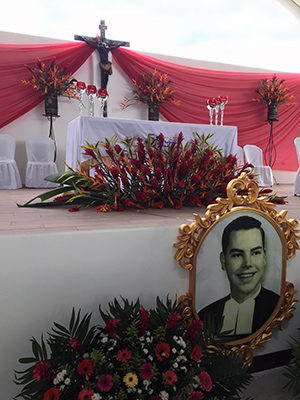
A portrait of Blessed James Miller, FSC, stands near the altar of the beatification Mass on Dec. 7 in Huehuetenango, Guatemala. Above, the Saint Mary’s delegation for the ceremony stands next to the bust of Blessed James in front of the Casa Indigena. The delegation includes, from left: Timothy Gossen, Marcy Van Fossen, Ann Merchlewitz, and Brother Robert Schieler, FSC, Superior General of the Brothers of Christian Schools; Brother Robert Smith, FSC; Brother Gustavo Ramirez Barba, FSC, General Councilor for Lasallian Higher Education; Alisa Macksey; Brother Timothy Coldwell, FSC, General Councilor for Lasallian Region of North America.
They again visited the section of the school wall where “Brother Santiago” (as everyone called him) was making repairs when he was shot by three masked men on Feb. 13, 1982, at the age of 37. The location, and its deep meaning, has not been changed by time.
They were surprised to see that a portion of one of Casa Indigena’s buildings had been transformed into a three-room museum that neatly preserved different artifacts from that fateful day. There, one can find the shirt Blessed James Miller wore, still caked with blood; a piece of tissue that was used to try and staunch the wound; and other mementos and photos.
It is suspected that Blessed James was killed because he and the other De La Salle Christian Brothers at Casa Indigena fought to keep young students from being forced into the military. He was recognized 38 years later with a Feast Day in his honor, which is celebrated on Feb. 13.
Blessed James was recognized as a Servant of God in 2010; in November 2018, Pope Francis recognized his martyrdom; his beatification occurred in December 2019; and now he must have one miracle posthumously attributed to him to reach the next, and final level, of sainthood.
Macksey, Dr. Van Fossen, and Dr. Gossen were joined by other representatives from Saint Mary’s for Blessed James’ beatification ceremony in Guatemala including, Brother Robert Smith, FSC ’76, Ph.D., senior vice president for University Initiatives and special advisor to the president; and Ann Merchlewitz, J.D., general counsel and university secretary. Several De La Salle Christian Brothers from the Winona Campus also joined, including Brothers Francis Carr, FSC ’66; Pat Conway, FSC ’75, M’80, Ed.D.; and Stephan Markham, FSC ’66.
Those in attendance said that the experience serves as a daily reminder of the Lasallian charism — which by definition is “a gift of the Spirit to the Church” — in the modern world. And given that Saint John Baptist de La Salle is the patron saint of teachers, that charism is historically rooted in education of the young, particularly those from marginalized backgrounds.
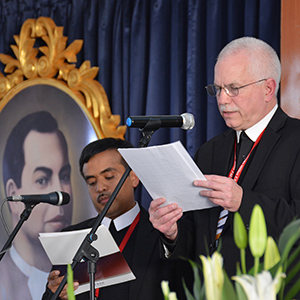
Brother Robert Smith, FSC, presents the Signum Fidei Award from Saint Mary’s to the District of Central America-Panama and the Midwest District, the two districts to which Blessed James Miller, FSC, belonged. To his left is Brother Francisco Boniche, FSC, who is translating the speech from English to Spanish.
“I hope the life of someone like Blessed James can inspire all of us to be the best of our ideals,” said Brother Robert. “De La Salle wrote, echoing John’s Gospel, ‘There is no greater love than to lay down your life for your students.’ Well, most of us lay them down in less dramatic ways than being martyred. We lay it down by spending a Sunday afternoon reading 100 student essays.”
The idea of the Lasallian Catholic charism was a focal point of the presentation given by Brother Thomas Johnson, FSC ’76, Ph.D, who served as the Vicar General of the De La Salle Christian Brothers from 2007 to 2014, as he spoke to both the Winona and Twin Cities campuses Feb. 12 and 13. His presentation, titled “Being a Catholic and Lasallian University in Today’s Diverse World,” was part of the Living Our Lasallian Catholic Identity Speaker Series.
Brother Thomas suggested that the act of teaching itself is a charism, “to make a loving and saving presence of Jesus Christ a visible and effective reality in the world of education, in the world of the young,” borrowing the definition from former Superior General Brother John Johnston, FSC ’55, M’63, in his 1994 work Living Authentically in Christ Jesus.
In the case of Blessed James, the youth he worked with were indigenous Guatemalans, who were often swept off the streets and forcefully conscripted into the country’s army. Blessed James and his fellow De La Salle Christian Brothers at the school not only protected them, they also provided these young boys with a secondary school education that included practical agricultural experience.

An aerial view of Huehuetenango, Guatemala.
“These were kids from the hills,” said Brother Robert, who first visited Huehuetenango two years after Blessed James was killed. “They were likely considered something less than fully human by the government and authorities.”’
Blessed James joined a list of members of Catholic religious orders who died protecting those they vowed to nurture and educate, as part of an overall period of history in Central America in the ’70s and ’80s.
“Blessed James is a wonderful example of the Lasallian mission,” Macksey added. “He was so humble. He didn’t go down to Guatemala wanting to be known for his work. He embodied that part of our charism and mission of educating those who weren’t being educated to improve their quality of life. And essentially, that’s why he was killed.”
The Lasallian charism is … introspective
Dr. Gossen first visited Huehuetenango, Guatemala, in 2002 as part of a group of five representatives from Saint Mary’s, who took a two-week trip to visit Lasallian ministries near the area.

A plaque marks the spot where Blessed James Miller, FSC, was shot and killed on Feb. 13, 1982, while fixing this wall.
“He was just a big man, a big presence,” Dr. Gossen said of Blessed James. “But for me, he was just normal. I think similarly about Saint John Baptist de La Salle or some of the other people who we recognize within the Brothers’ religious order. They are just normal men who have done extraordinary things. And in this case, and in many other cases, they stood up for the rights of their students.”
Dr. Gossen began his Lasallian journey as a freshman at Saint Mary’s in 1997. Upon completing his undergraduate degree in psychology, he began working at Saint Mary’s in several capacities including as the vice president for Mission, in which he served as a liaison between the De La Salle Christian Brothers and the university.
Around the same time he graduated, he also lived with the De La Salle Christian Brothers on the Winona Campus for two years as a Brother candidate to determine if that was his calling. It was not, but being a part of Lasallian higher education was.
The mission of Saint Mary’s reads as follows: “Enriched by the Lasallian Catholic heritage, Saint Mary’s University of Minnesota awakens, nurtures, and empowers learners to ethical lives of service and leadership.”
Dr. Gossen said he believes the mission is founded in faith and hope, as he circles back to the importance of the word “nurtures.”
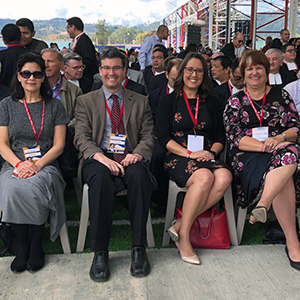
Members of the Saint Mary’s delegation at the beatification Mass for Blessed James Miller, FSC, from left: Marcy Van Fossen, Timothy Gossen, Alisa Macksey and Ann Merchlewitz.
“We believe there’s something inside students already,” he said. “They’re not an empty vessel, but there is something inside of them that needs to be nurtured, and that’s our mission.”
One interesting fact that has stuck with him when reflecting on Lasallian teachings is the act of De La Salle naming the De La Salle Christian Brothers. Instead of the traditional patriarchal title of fathers, he decided to call them Brothers, given that they were to be Brothers to one another and older Brothers to the students who were entrusted to their care.
“It’s a relational piece,” Dr. Gossen said. “We’re going to gather. There’s a community. We’re a family.”
To Dr. Gossen, Catholic higher education is where “the church does its thinking,” a notion that has helped lead him to oversee the publication of AXIS: Journal of Lasallian Higher Education.
“It’s where we can have dialogue and discuss important topics. It’s where we can unpack things and explore,” he said. “In Lasallian education, we may not necessarily agree on everything, but we can have meaningful conversations.”
Read more about being Lasallian in part two of the series next week.
RELATED MATERIAL:
Saint Mary’s Magazine (Fall 2007): “Living and Learning Lasallian”
